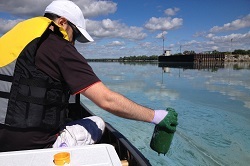Earth observation data at your fingertips in a blooming, marvellous suite of tools
Cyanobacteria(opens in new window), historically called blue-green algae but now classified as bacteria given their lack of a membrane-bound nucleus, are among the smallest, simplest and most ancient cells. They provided the oxygen in our atmosphere that shaped the evolution of our planet and, despite their ‘age’ and relative simplicity, cyanobacteria continue to have an important impact – but not always positive. Cyanobacterial harmful algal ‘blooms’(opens in new window) are a growing global environmental and public health problem. The EU funded CyanoAlert(opens in new window) project is making the monitoring and management of cyanobacterial blooms simpler and more effective by leveraging the EU’s ground-breaking satellite-based Copernicus(opens in new window) Earth observation (EO) programme.
More than meets the eye
When cyanobacteria, normally found in water, suddenly find themselves in slow-moving waters rich in nutrients from sources including fertiliser runoff or septic tank overflows, they can multiply rapidly forming blooms. These beautiful swathes of green threaten water quality in lakes and coastal areas. They can quickly and detrimentally affect light and oxygen availability in marine ecosystems, produce toxins harmful to people and other organisms, and harm coastal economies reliant on fishing, tourism and recreation. Water quality can be assessed by various biological and physical chemical quality parameters. Getting a handle on the temporal variability and spatial distribution of these parameters in practice would typically mean extensive and expensive sampling programs. Thanks to the CyanoAlert® service, this need can be addressed with near real time EO data, unprecedented in other products and services. CyanoAlert® enables the detection and assessment of cyanobacterial bloom occurrences globally and provides complementary water quality information, such as chlorophyll concentration and turbidity. Project coordinator Petra Philipson of Brockmann Geomatics Sweden AB(opens in new window) explains: “CyanoAlert® was developed for authorities, organisations, researchers and commercial actors who need data and information for monitoring and management of lakes and coastal areas. It consists of three main tools: a viewer(opens in new window) for visualisation of satellite images and water quality products, a subscription service(opens in new window) with near real-time, user-specific information for monitoring and reporting purposes, and a freely available mobile application(opens in new window) with the current status of selected water bodies in Europe and the possibility to report your own observations.” The subscription service integrates the EO data with users’ daily activities – users can set alert criteria and threshold values in areas of interest to them and receive alerts in near real time.
Poised for tremendous growth
The CyanoAlert project enabled the team to establish a sustainable supply chain and begin commercial exploitation of CyanoAlert®, with the first fee-based service in June 2020. This will significantly improve the spatial and temporal frequency of monitoring, enhancing the information available to the service and enabling long-term cost savings. Philipson summarises: “CyanoAlert® improves the temporal and spatial detail of water quality information and potentially threatening blooms through quick and simple access to appropriate EO-based products for different types of water managers.” Download the application(opens in new window) and start monitoring your favourite lakes and coastal towns to plan your next bloom-free swim or canoe trip.







